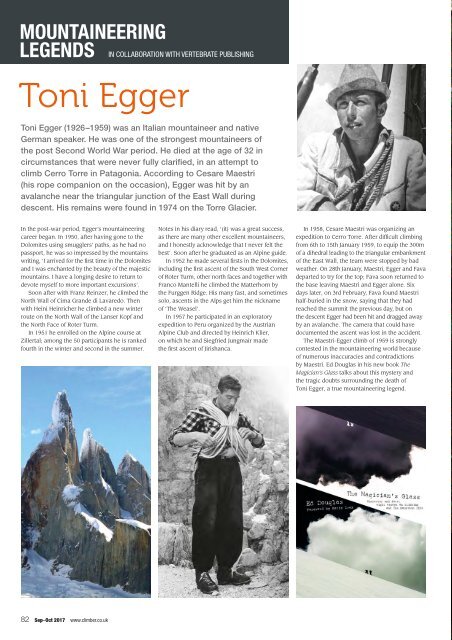You also want an ePaper? Increase the reach of your titles
YUMPU automatically turns print PDFs into web optimized ePapers that Google loves.
Mountaineering<br />
Legends in collaboration with Vertebrate Publishing<br />
Toni Egger<br />
Toni Egger (1926–1959) was an Italian mountaineer and native<br />
German speaker. He was one of the strongest mountaineers of<br />
the post Second World War period. He died at the age of 32 in<br />
circumstances that were never fully clarified, in an attempt to<br />
climb Cerro Torre in Patagonia. According to Cesare Maestri<br />
(his rope companion on the occasion), Egger was hit by an<br />
avalanche near the triangular junction of the East Wall during<br />
descent. His remains were found in 1974 on the Torre Glacier.<br />
In the post-war period, Egger’s mountaineering<br />
career began. In 1950, after having gone to the<br />
Dolomites using smugglers’ paths, as he had no<br />
passport, he was so impressed by the mountains<br />
writing, ‘I arrived for the first time in the Dolomites<br />
and I was enchanted by the beauty of the majestic<br />
mountains. I have a longing desire to return to<br />
devote myself to more important excursions’.<br />
Soon after with Franz Reinzer, he climbed the<br />
North Wall of Cima Grande di Lavaredo. Then<br />
with Heini Heinricher he climbed a new winter<br />
route on the North Wall of the Lanser Kopf and<br />
the North Face of Roter Turm.<br />
In 1951 he enrolled on the Alpine course at<br />
Zillertal; among the 50 participants he is ranked<br />
fourth in the winter and second in the summer.<br />
Notes in his diary read, ‘(it) was a great success,<br />
as there are many other excellent mountaineers,<br />
and I honestly acknowledge that I never felt the<br />
best’. Soon after he graduated as an Alpine guide.<br />
In 1952 he made several firsts in the Dolomites,<br />
including the first ascent of the South West Corner<br />
of Roter Turm, other north faces and together with<br />
Franco Mantelli he climbed the Matterhorn by<br />
the Furggen Ridge. His many fast, and sometimes<br />
solo, ascents in the Alps get him the nickname<br />
of ‘The Weasel’.<br />
In 1957 he participated in an exploratory<br />
expedition to Peru organized by the Austrian<br />
Alpine Club and directed by Heinrich Klier,<br />
on which he and Siegfried Jungmair made<br />
the first ascent of Jirishanca.<br />
In 1958, Cesare Maestri was organizing an<br />
expedition to Cerro Torre. After difficult climbing<br />
from 6th to 15th January 1959, to equip the 300m<br />
of a dihedral leading to the triangular embankment<br />
of the East Wall, the team were stopped by bad<br />
weather. On 28th January, Maestri, Egger and Fava<br />
departed to try for the top; Fava soon returned to<br />
the base leaving Maestri and Egger alone. Six<br />
days later, on 3rd February, Fava found Maestri<br />
half-buried in the snow, saying that they had<br />
reached the summit the previous day, but on<br />
the descent Egger had been hit and dragged away<br />
by an avalanche. The camera that could have<br />
documented the ascent was lost in the accident.<br />
The Maestri-Egger climb of 1959 is strongly<br />
contested in the mountaineering world because<br />
of numerous inaccuracies and contradictions<br />
by Maestri. Ed Douglas in his new book The<br />
Magician’s Glass talks about this mystery and<br />
the tragic doubts surrounding the death of<br />
Toni Egger, a true mountaineering legend.<br />
82 Sep–Oct <strong>2017</strong> www.climber.co.uk






